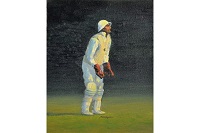The Sandham Chapel
Yesterday in the company of Alice Mansfield and Douglas Heath I visited the Stanley Spencer chapel in Burghclere, Newbury. For a number of reasons I was underwhelmed.
First the chapel itself seems more a modern crematorium more than a spiritual place.
Second, it had a rather confused gestation. The sponsors were John Louis, a Jew, and his gentile wife Mary Behrend. Because of his marrying “out” John Louis was disinherited so the couple were not replete with money. Nonetheless less they bought the land in 1923 in Burghclere where they lived and supported many aspiring people of the arts such as Benjamin Britten.
 Through the artist Henry Lamb they met Stanley Spencer and he was the brainchild for the panels inside the chapel. Stanley Spencer was strongly influenced by the Giotto chapel which it resembles. He served in the Great War as an orderly in the Beaufort Hospital in Bristol and then in the Royal Berkshires in the now somewhat neglected Salonika campaign.
Through the artist Henry Lamb they met Stanley Spencer and he was the brainchild for the panels inside the chapel. Stanley Spencer was strongly influenced by the Giotto chapel which it resembles. He served in the Great War as an orderly in the Beaufort Hospital in Bristol and then in the Royal Berkshires in the now somewhat neglected Salonika campaign.
In my opinion, although Spencer was an official war artist, his war paintings lack the impact of a Nevinson, Singer Sargent or Paul Nash. They are of considerable historical/medical importance in reflecting the drudgery of the war hospital but Alice said he was the most eclectic of artist although his beloved Cookham was a common theme.
To make matters more complicated Mary Sandham wanted the chapel commemorated to her brother Harry who contracted malaria in Salonika but died in 1920 and was not an honoured war casualty.
However there is only a plaque to him outside the chapel which is now celebrated as an oeuvre for one of Britain’s finest twentieth century painters.
At the time Spencer was commissioned by the Benrends and working on the panels (1927-32) , living in Burghclere his personal life was in turmoil as he left his wife Hilda for Patricia Preece who then immediately returned to her girlfriend.
There is no doubting the impact of entering the chapel and seeing the three sides covered by the panels reflecting life in Beaufort and the Salonika campaign, the latter in huge tableaux of the camp at Karasuki where Spencer was on duty inthe ambulance service and the river bed in Todorovo. Alice said she still preferred the eclectism of the Stanley Spencer museum at Cookham as reflective of his genius.
 After Burghclere we proceeded on to Chipping Sodbury as Duggie wanted to buy from Jack Russell, who has his gallery there, his study of wicket keeper Alan Knott.
After Burghclere we proceeded on to Chipping Sodbury as Duggie wanted to buy from Jack Russell, who has his gallery there, his study of wicket keeper Alan Knott.


